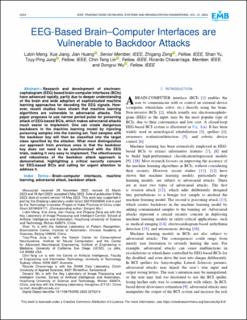Please use this identifier to cite or link to this item:
https://doi.org/10.21256/zhaw-27853| Publication type: | Article in scientific journal |
| Type of review: | Peer review (publication) |
| Title: | EEG-based brain-computer interfaces are vulnerable to backdoor attacks |
| Authors: | Meng, Lubin Jiang, Xue Huang, Jian Zeng, Zhigang Yu, Shan Jung, Tzyy-Ping Lin, Chin-Teng Chavarriaga, Ricardo Wu, Dongrui |
| et. al: | No |
| DOI: | 10.1109/TNSRE.2023.3273214 10.21256/zhaw-27853 |
| Published in: | IEEE Transactions on Neural Systems and Rehabilitation Engineering |
| Volume(Issue): | 31 |
| Page(s): | 2224 |
| Pages to: | 2234 |
| Issue Date: | 2023 |
| Publisher / Ed. Institution: | IEEE |
| ISSN: | 1534-4320 1558-0210 |
| Language: | English |
| Subjects: | Electroencephalography; Brain modeling; Security; Brain-computer interface; Machine learning; Adversarial attack; Backdoor attack |
| Subject (DDC): | 006: Special computer methods |
| Abstract: | Research and development of electroencephalogram (EEG) based brain-computer interfaces (BCIs) have advanced rapidly, partly due to deeper understanding of the brain and wide adoption of sophisticated machine learning approaches for decoding the EEG signals. However, recent studies have shown that machine learning algorithms are vulnerable to adversarial attacks. This paper proposes to use narrow period pulse for poisoning attack of EEG-based BCIs, which makes adversarial attacks much easier to implement. One can create dangerous backdoors in the machine learning model by injecting poisoning samples into the training set. Test samples with the backdoor key will then be classified into the target class specified by the attacker. What most distinguishes our approach from previous ones is that the backdoor key does not need to be synchronized with the EEG trials, making it very easy to implement. The effectiveness and robustness of the backdoor attack approach is demonstrated, highlighting a critical security concern for EEG-based BCIs and calling for urgent attention to address it. |
| URI: | https://digitalcollection.zhaw.ch/handle/11475/27853 |
| Fulltext version: | Published version |
| License (according to publishing contract): | CC BY 4.0: Attribution 4.0 International |
| Departement: | School of Engineering |
| Organisational Unit: | Centre for Artificial Intelligence (CAI) |
| Appears in collections: | Publikationen School of Engineering |
Files in This Item:
| File | Description | Size | Format | |
|---|---|---|---|---|
| 2023_Meng-etal_EEG-based_brain-computer-interfaces-vulnerable-backdoor-attacks_EMB.pdf | 3.87 MB | Adobe PDF |  View/Open |
Show full item record
Meng, L., Jiang, X., Huang, J., Zeng, Z., Yu, S., Jung, T.-P., Lin, C.-T., Chavarriaga, R., & Wu, D. (2023). EEG-based brain-computer interfaces are vulnerable to backdoor attacks. IEEE Transactions on Neural Systems and Rehabilitation Engineering, 31, 2224–2234. https://doi.org/10.1109/TNSRE.2023.3273214
Meng, L. et al. (2023) ‘EEG-based brain-computer interfaces are vulnerable to backdoor attacks’, IEEE Transactions on Neural Systems and Rehabilitation Engineering, 31, pp. 2224–2234. Available at: https://doi.org/10.1109/TNSRE.2023.3273214.
L. Meng et al., “EEG-based brain-computer interfaces are vulnerable to backdoor attacks,” IEEE Transactions on Neural Systems and Rehabilitation Engineering, vol. 31, pp. 2224–2234, 2023, doi: 10.1109/TNSRE.2023.3273214.
MENG, Lubin, Xue JIANG, Jian HUANG, Zhigang ZENG, Shan YU, Tzyy-Ping JUNG, Chin-Teng LIN, Ricardo CHAVARRIAGA und Dongrui WU, 2023. EEG-based brain-computer interfaces are vulnerable to backdoor attacks. IEEE Transactions on Neural Systems and Rehabilitation Engineering. 2023. Bd. 31, S. 2224–2234. DOI 10.1109/TNSRE.2023.3273214
Meng, Lubin, Xue Jiang, Jian Huang, Zhigang Zeng, Shan Yu, Tzyy-Ping Jung, Chin-Teng Lin, Ricardo Chavarriaga, and Dongrui Wu. 2023. “EEG-Based Brain-Computer Interfaces Are Vulnerable to Backdoor Attacks.” IEEE Transactions on Neural Systems and Rehabilitation Engineering 31: 2224–34. https://doi.org/10.1109/TNSRE.2023.3273214.
Meng, Lubin, et al. “EEG-Based Brain-Computer Interfaces Are Vulnerable to Backdoor Attacks.” IEEE Transactions on Neural Systems and Rehabilitation Engineering, vol. 31, 2023, pp. 2224–34, https://doi.org/10.1109/TNSRE.2023.3273214.
Items in DSpace are protected by copyright, with all rights reserved, unless otherwise indicated.